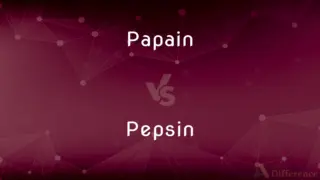Roller vs. Pulley — What's the Difference?
By Urooj Arif & Maham Liaqat — Updated on March 27, 2024
A roller is cylinder or wheel that rotates around a central axis to facilitate movement or support of objects, while a pulley is wheel with a grooved rim in which a rope, cable, or belt runs to change the direction of the force applied to move an object.

Difference Between Roller and Pulley
Table of Contents
ADVERTISEMENT
Key Differences
Rollers are primarily used to support, move, or guide materials and objects along a path, often found in conveyors, printers, and various machinery. On the other hand, pulleys are specifically designed to lift weights, apply forces, and transmit power by utilizing tension in the rope or belt that runs through their grooved rims.
While rollers can be passive elements, simply allowing objects to glide or roll over their surface, pulleys actively change the direction and magnitude of forces, making them crucial in mechanical systems for lifting or moving objects with minimal effort. In contrast, the primary function of a roller is to reduce friction and facilitate smooth movement.
The design of a roller focuses on minimizing resistance and wear, often featuring materials like rubber, plastic, or metal, depending on the application. Conversely, pulleys are constructed with a focus on their ability to accommodate ropes or belts, with durability and smoothness of the groove being paramount to prevent wear on the moving parts.
In terms of application, rollers are ubiquitous in manufacturing lines, material handling systems, and even as parts of larger machinery like printers and copiers. Pulleys, however, are integral to lifting mechanisms, such as cranes and elevators, and are also found in engines and other devices where power transmission is required.
Despite their differences, both rollers and pulleys are essential components in mechanical and industrial applications, each serving distinct purposes that exploit their unique designs to facilitate movement and force application in an efficient manner.
ADVERTISEMENT
Comparison Chart
Function
Facilitates movement or support of objects
Changes direction and magnitude of force applied
Design Focus
Minimizing resistance and wear
Accommodating ropes or belts with a grooved rim
Primary Use
Support, move, or guide materials
Lift weights, transmit power
Material
Rubber, plastic, metal (depends on application)
Durable materials with smooth grooves
Application
Conveyors, printers, machinery
Cranes, elevators, engines
Compare with Definitions
Roller
A cylinder or wheel that rotates around a central axis, used to facilitate movement.
The conveyor belt runs smoothly over a series of rollers.
Pulley
A wheel on an axle or shaft designed to support movement and change of direction of a taut cable or belt.
The old well used a simple pulley system to draw water.
Roller
Often used to reduce friction and support moving parts.
The printer's paper feed mechanism includes several small rollers.
Pulley
Essential for lifting mechanisms and power transmission.
Pulleys in the elevator shaft facilitate the smooth ascent and descent of the cabin.
Roller
Can be found in various sizes and materials, depending on the application.
Heavy-duty rollers made of steel are used in industrial conveyors.
Pulley
Designed for efficiency and durability in various applications.
The sailboat's rigging includes multiple pulleys to adjust the sails.
Roller
Plays a crucial role in material handling and transportation.
Rollers in the airport baggage system ensure luggage is transported efficiently.
Pulley
Utilizes grooves to guide ropes, cables, or belts.
The engine's timing belt runs through a series of pulleys.
Roller
Provides support and direction without changing the force direction.
The sliding gate moves easily on its ground-mounted rollers.
Pulley
Can significantly reduce the effort needed to lift heavy objects.
Using a pulley system, the workers lifted the steel beams to the upper floors.
Roller
A cylinder that rotates about a central axis and is used in various machines and devices to move, flatten, or spread something
Use a roller to resettle turf laid during autumn and winter
The sheets moved through rollers and down the folding machine
Pulley
A pulley is a wheel on an axle or shaft that is designed to support movement and change of direction of a taut cable or belt, or transfer of power between the shaft and cable or belt. In the case of a pulley supported by a frame or shell that does not transfer power to a shaft, but is used to guide the cable or exert a force, the supporting shell is called a block, and the pulley may be called a sheave.
Roller
A long swelling wave that appears to roll steadily towards the shore
The Atlantic rollers
Pulley
A wheel with a grooved rim around which a cord passes, which acts to change the direction of a force applied to the cord and is used to raise heavy weights.
Roller
Relating to or involving roller skates
Roller hockey
Pulley
Hoist with a pulley
The tree house was built on the ground and pulleyed into the branches
Roller
A brightly coloured crow-sized bird with predominantly blue plumage, having a characteristic tumbling display flight.
Pulley
A simple machine consisting essentially of a wheel with a grooved rim in which a pulled rope or chain can run to change the direction of the pull, for example to lift a load.
Roller
A bird of a breed of tumbler pigeon.
Pulley
A wheel turned by or driving a belt.
Roller
A breed of canary with a trilling song.
Pulley
One of the simple machines; a sheave, a wheel with a grooved rim, in which a pulled rope or chain lifts an object (more useful when two or more pulleys are used together, as in a block and tackle arrangement, such that a small force moving through a greater distance can exert a larger force through a smaller distance).
Roller
A car made by Rolls-Royce.
Pulley
(transitive) To raise or lift by means of a pulley.
Roller
One that rolls or performs a rolling operation or activity.
Pulley
A wheel with a broad rim, or grooved rim, for transmitting power from, or imparting power to, the different parts of machinery, or for changing the direction of motion, by means of a belt, cord, rope, or chain.
Roller
A small spokeless wheel, such as that of a roller skate or caster.
Pulley
To raise or lift by means of a pulley.
Roller
An elongated cylinder on which something, such as a window shade or towel, is wound.
Pulley
A simple machine consisting of a wheel with a groove in which a rope can run to change the direction or point of application of a force applied to the rope
Roller
A heavy revolving cylinder that is used to level, crush, or smooth.
Roller
(Printing) A cylinder, usually of hard rubber, used to ink the type before the paper is impressed.
Roller
A cylinder of wire mesh, foam rubber, or other material around which a strand of hair is wound to produce a soft curl or wave.
Roller
A long rolled bandage.
Roller
A heavy swelling wave that breaks on a coast.
Roller
A tumbler pigeon.
Roller
Any of various Eurasian, African, or Australian birds of the genera Coracias and Eurystomus, characteristically having bright blue wings, stocky bodies, and hooked bills. They are noted for their habit of rolling and twisting in flight, especially during display flights.
Roller
A breed of canary kept for its soft, trilling song.
Roller
(heading) Anything that rolls.
Roller
Any rotating cylindrical device that is part of a machine, especially one used to apply or reduce pressure.
Roller
A cylindrical (or approximately cylindrical) item used under a heavy object to facilitate moving it; usually several are needed.
Roller
A person who rolls something, such as cigars or molten metal.
Roller
(cricket) A large rolling device used to flatten the surface of the pitch.
Roller
A cylindrical tool for applying paint or ink.
Roller
An agricultural machine used for flattening land and breaking up lumps of earth.
Roller
One of a set of small cylindrical tubes used to curl hair.
Roller
A roller towel.
Roller
A small wheel, as of a caster, a roller skate, etc.
Roller
(cycling) One of a set of rolling cylinders allowing a rider to practise balance while training indoors.
Roller
Any insect whose larva rolls up leaves, especially those in family Tortricidae.
Roller
A dung beetle that rolls dung into balls.
Roller
The pl=s, small ground snakes of the genus Cylindrophis.
Roller
A rolling pin
Roller
(disc golf) A throw which involves the player throwing the disc in a way that makes it roll, by that being able to travel further than if thrown in the air. Only used on holes with open areas with short or no grass.
He threw a beautiful roller that cut the corner perfectly and stopped just outside the circle.
Roller
A long wide bandage used in surgery.
Roller
A large, wide, curling wave that falls back on itself as it breaks on a coast.
Roller
(heading) A bird.
Roller
A breed or variety of roller pigeon that rolls (i.e. tumbles or somersaults) backwards (compare Penson roller, Birmingham roller, tumbler).
Roller
Any of various aggressive birds, of the family Coraciidae, having bright blue wings and hooked beaks.
Roller
A police patrol car or patrolman (rather than an unmarked police car or a detective)
Roller
A padded surcingle that is used on horses for training and vaulting.
Roller
A roll of titles or (especially) credits played over film or video; television or film credits.
Roller
(slang) A wheelchair user.
Roller
(intransitive) To roller skate.
Roller
One who, or that which, rolls; especially, a cylinder, sometimes grooved, of wood, stone, metal, etc., used in husbandry and the arts.
Roller
A bandage; a fillet; properly, a long and broad bandage used in surgery.
Roller
One of series of long, heavy waves which roll in upon a coast, sometimes in calm weather.
Roller
A long, belt-formed towel, to be suspended on a rolling cylinder; - called also roller towel.
Roller
A cylinder coated with a composition made principally of glue and molassess, with which forms of type are inked previously to taking an impression from them.
Roller
A long cylinder on which something is rolled up; as, the roller of a map.
Roller
A small wheel, as of a caster, a roller skate, etc.
Roller
Any insect whose larva rolls up leaves; a leaf roller. see Tortrix.
Roller
Any one of numerous species of Old World picarian birds of the family Coraciadæ. The name alludes to their habit of suddenly turning over or "tumbling" in flight.
Roller
Any species of small ground snakes of the family Tortricidæ.
Roller
A grounder that rolls along the infield
Roller
A long heavy sea wave as it advances towards the shore
Roller
A small wheel without spokes (as on a roller skate)
Roller
A cylinder that revolves
Roller
A mechanical device consisting of a cylindrical tube around which the hair is wound to curl it;
A woman with her head full of curlers is not a pretty sight
Roller
Old World bird that tumbles or rolls in flight; related to kingfishers
Roller
Pigeon that executes backward somersaults in flight or on the ground
Common Curiosities
Where are pulleys commonly used?
Pulleys are used in lifting mechanisms, power transmission systems, and any application requiring force direction change or effort reduction.
How does a pulley work?
A pulley changes the direction and magnitude of the force applied through a rope, cable, or belt running along its grooved rim.
What is the primary function of a roller?
To facilitate movement or support objects by allowing them to roll over its surface.
What types of materials are used to make rollers?
Rollers can be made from rubber, plastic, metal, and other materials suited to the specific application's needs.
Are rollers and pulleys interchangeable?
No, they serve different purposes in mechanical systems; rollers support movement, while pulleys change force direction.
Do all pulleys have grooved rims?
Yes, the grooved rim is essential for guiding and holding the rope, cable, or belt in place.
How do pulleys reduce effort in lifting weights?
By changing the direction of force, pulleys allow for more advantageous application of force, often letting gravity work to the user's benefit.
Can rollers change the direction of the force applied?
No, rollers primarily reduce friction and support movement, not altering force direction.
Can both rollers and pulleys be part of the same system?
Yes, in complex mechanical systems, rollers can support movement while pulleys manage force direction and application.
Why are pulleys considered essential in mechanical systems?
They are crucial for their ability to facilitate the efficient application of force, enhancing the functionality of lifting systems and power transmission.
What are some everyday applications of rollers?
Rollers are used in printers, conveyors, and as part of the mechanisms in sliding doors and gates.
How are pulleys integrated into engine systems?
In engines, pulleys are used to transmit power from the crankshaft to other components, such as the alternator, via belts.
What is the significance of the material choice for rollers?
The material affects the roller's durability, friction level, and suitability for the object or material being moved.
Can pulleys be used to increase force as well as change its direction?
Yes, by using systems of pulleys (block and tackle), you can increase the mechanical advantage and lift heavier objects with less effort.
Are there different types of rollers for specific uses?
Yes, rollers are designed with different materials, sizes, and shapes to suit various applications, from industrial machinery to everyday items.
Share Your Discovery

Previous Comparison
Papain vs. Pepsin
Next Comparison
Utterance vs. SentenceAuthor Spotlight
Written by
Urooj ArifUrooj is a skilled content writer at Ask Difference, known for her exceptional ability to simplify complex topics into engaging and informative content. With a passion for research and a flair for clear, concise writing, she consistently delivers articles that resonate with our diverse audience.
Co-written by
Maham Liaqat












































